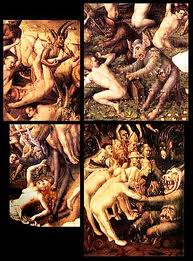The Satanic Phenomenon: Medieval Representations of Satan

Matos, Morgan A.
Masters of Liberal Studies Theses, Rollins College, Paper 28, July (2011)
Abstract: This project deals with the one and only character of Satan, revealing him through the eyes of the medieval world. The ever-evolving, interconnectedness of culture, religion, and superstition make for a truly unique theatrical experience in the middle ages. With limited understanding and access to scripture, medieval Christians generated a blended belief system, in order to make sense of the metaphysical world, which manifests itself in medieval drama‟s representations of Satan. While the medieval character of Satan upholds many of the Church‟s teachings about his nature and purpose, he takes on a new persona when left to the dramatic interpretation of the laity, as opposed to the interpretation of the monastic writer, scholar, or prophetic poet. The literary work of Dante and Milton deliver valuable satanic representations, arguably trumping all others, but something essential is lacking there, when compared to the Satan found on the medieval stage, who now resides not in hell, but in the shadow of Dante and Milton’s Satan.
Introduction: When one begins to research medieval drama, art, and culture a familiar figure begins to pop up in multiple places. He can be seen in Hildegard’s Scivias, a series of painted tiles that portray apocalyptic scenes, along with other religious art adorning cathedral walls. His names can be heard in folklore, urban legends, and superstitions passed down through generations and spread from one town to the next. The medieval era brings us a character catapulted from the position of a familiar name to complete phenomenon, stealing scenes, causing mayhem in the streets, and making sin something to laugh about, while in the same breath making folks fearful for their soul. This project deals with the one and only character of Satan, revealing him through the eyes of the medieval world.
The ever-evolving, interconnectedness of culture, religion, and superstition make for a truly unique theatrical experience in the middle ages. With limited understanding and access to scripture, medieval Christians generated a blended belief system, in order to make sense of the metaphysical world, which manifests itself in medieval drama’s representations of Satan. While the medieval character of Satan upholds many of the Church’s teachings about his nature and purpose, he takes on a new persona when left to the dramatic interpretation of the laity, as opposed to the interpretation of the monastic writer, scholar, or prophetic poet. The literary work of Dante and Milton deliver valuable satanic representations, arguably trumping all others, but something essential is lacking there, when compared to the Satan found on the medieval stage, who now resides not in hell, but in the shadow of Dante and Milton’s Satan.
No comments:
Post a Comment